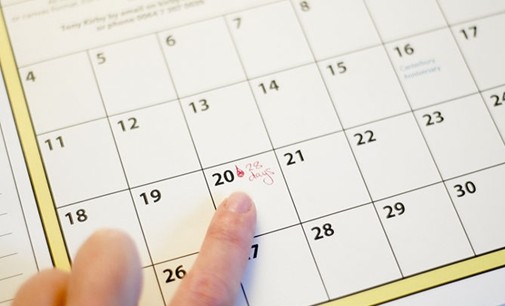Knowing your most fertile days will increase your chances of conception and these days are influenced by the lifespan of sperm and eggs as well as your menstrual cycle. In order for conception to occur, the sperm has to reach a mature egg before either one of these dies. There are multiple factors used when finding your fertile days and these include knowing your menstrual cycle, fertility signs, and average cycle length, or even use an ovulation calculator.
How to Calculate Your Most Fertile Days
Knowing how to calculate your most fertile days can help you determine when you are ovulating, allowing you to time intercourse to either avoid pregnancy or increase your chances of conception.
1. Chart the Length of Your Menstrual Cycle
 By tracking your menstrual cycle, you can determine how long your luteal and follicular phases normally are. As long as your cycles are regular, this will also help you determine when you ovulate. Get a spreadsheet or calendar and mark the first day in your menstrual cycle as day one and also note the day when your menstruation ends. Once your next period starts begin again at day one. Continue this process for three to four months as more information will lead to a more accurate estimate of your fertile days.
By tracking your menstrual cycle, you can determine how long your luteal and follicular phases normally are. As long as your cycles are regular, this will also help you determine when you ovulate. Get a spreadsheet or calendar and mark the first day in your menstrual cycle as day one and also note the day when your menstruation ends. Once your next period starts begin again at day one. Continue this process for three to four months as more information will lead to a more accurate estimate of your fertile days.
This method can help you have a better idea of the length of your menstrual cycle and whether or not your cycle is regular. You can also have a better idea when your next cycle is likely to start and use the following method to calculate your ovulation and most fertile days.
2. Your Most Fertile Days
Most eggs will live for between 12 and 24 hours following ovulation and sperm can usually survive 5 days in a vaginal environment which is hospitable. Because of this, you will be most fertile 5 days before you ovulate the day of your ovulation. Most of the time ovulation happens between 12 and 16 days before the start of the menstrual period. This means that if your cycle is 24 days, it will be on day 10; if it is 28 days it will occur on day 14; if it is a 35 day cycle it will be on day 21. Based on this information, you can figure out your most fertile days of the month based on your cycle. The following chart can help you by doing most of the math for you:
|
Fertile Days Based on Different Cycle Length |
|
|
Cycle Length |
Most Fertile Days |
|
24-day cycle |
Day 5 through day 10 of menstrual cycle |
|
28-day cycle |
Day 9 through day 14 of menstrual cycle |
|
30-day cycle |
Day 11 through day 16 of menstrual cycle |
|
35-day cycle |
Day 16 through day 21 of menstrual cycle |
Notes on Contraception: If you plan on using fertility awareness as birth control, you need to avoid sex for somewhere between 8 and 16 days of each of your menstrual cycles. If you do not avoid sex, you must use a condom, diaphragm, or other barrier method for birth control. In order to accurately use this method, you need to be ready each month, be aware of how your body changes, and be open with your partner concerning your cycle.
What Are the Signs of Ovulation?
In some cases, however, a woman will have irregular cycles and then you need to be aware of other signs to indicate when you are ovulating.
1. Cervical Mucus Changes
If your cervical fluid is similar to egg whites in consistency and appearance, then you are probably either ovulating or close to it. It is possible for all women to experience unique cervical fluids and there is variation for everyone. However, ovulation is usually the day with the largest quantity of wet fluid.
2. Basal Body Temperature Changes
Most women will experience a consistent basal body temperature before they ovulate. It might decline slightly before ovulation, but the biggest change is a large increase in temperature following ovulation. This signals ovulation and if you track it over time, you can predict when you ovulate.
3. Cervical Firmness or Position Changes
During ovulation your cervix will undergo many changes. You may notice that your cervix is high, wet, open, and soft. Most women need to pay attention for several cycles and be in touch with their bodies to be able to tell the difference between the feelings of a cervix normally and during ovulation.
4. Secondary Signs
Secondary signs won’t necessarily occur with all women, but they can indicate ovulation. Some symptoms include increased sex drive, abdominal bloating, breast tenderness, slight pain or cramping on a side of your pelvis, light spottingor a heightened sense of vision, taste, or smell.
5. Use an Ovulation Predictor Kit
You can buy ovulation predictor kits in the store and they will be able to tell you between 12 and 24 hours ahead of your ovulation. They do this by detecting your luteinizing hormone (LH) levels as this hormone is the final one to peak before you actually ovulate. You just need urine for the test to tell you if you will start ovulating soon.
Last but not least, you can use our Ovulation Calculator to predict your ovulation date and your most fertile days.
Most Fertile Days to Get Pregnant – How to Find Out When You Are Most Fertile:
